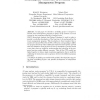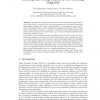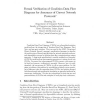236 search results - page 45 / 48 » On the Algebraic Structure of Petri Nets |
AGENTS
2000
Springer
13 years 11 months ago
2000
Springer
This paper presents a knowledge approach to designing team training systems using intelligent agents. We envision a computer-based training system in which teams are trained by pu...
APN
1994
Springer
13 years 11 months ago
1994
Springer
In this paper we describe a modelling project to improve a nuclear waste management program in charge of the creation of a new system for the permanent disposal of nuclear waste. S...
AGTIVE
2007
Springer
13 years 11 months ago
2007
Springer
Meta-modeling is well known to define the basic concepts of domain-specific languages in an object-oriented way. Based on graph transformation, an abstract meta-model may be enhanc...
ACSD
2003
IEEE
13 years 11 months ago
2003
IEEE
Abstract. The behaviour of asynchronous circuits is often described by Signal Transition Graphs (STGs), which are Petri nets whose transitions are interpreted as rising and falling...
AINA
2003
IEEE
13 years 11 months ago
2003
IEEE
Condition Data Flow Diagrams (CDFDs) are a formalized notation resulting from the integration of Yourdon Data Flow Diagrams, Petri Nets, and pre-post notation. They are used in th...



